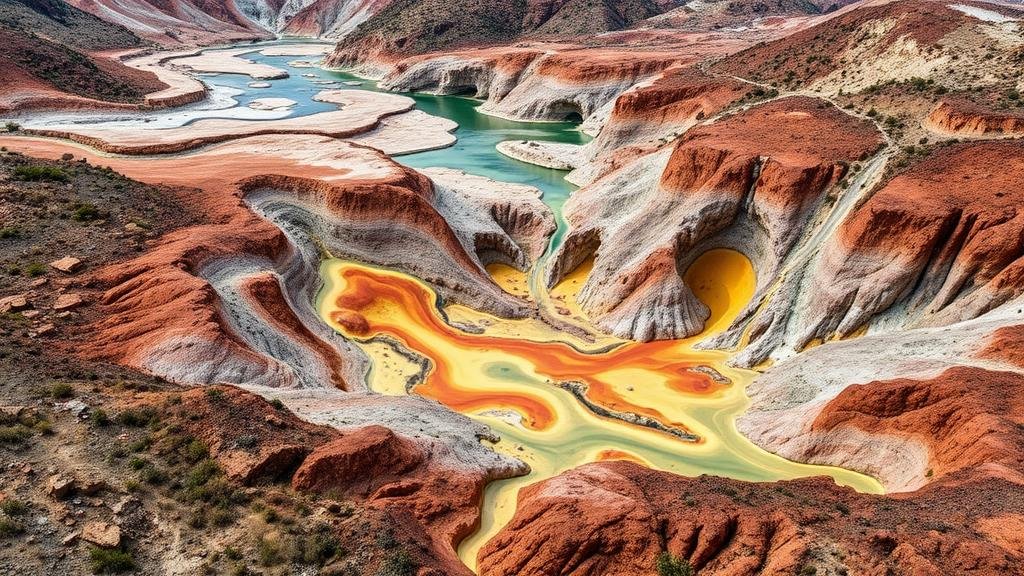Spotting Ore Deposits in Hydrothermally Altered Zones
Spotting Ore Deposits in Hydrothermally Altered Zones
Understanding where to locate ore deposits is pivotal for mining exploration and development. Hydrothermal alteration zones provide essential clues for geologists and prospectors. These zones, characterized by the interaction of hydrothermal fluids with host rocks, can create rich deposits of metals, including gold, copper, and silver. This article explores the methods for identifying these altered zones and the ore deposits they may contain.
The Formation of Hydrothermal Alteration Zones
Hydrothermal alteration involves the chemical alteration of rocks due to the circulation of heated fluids, often associated with volcanic activity or tectonic events. These processes can lead to significant mineralogical changes. Key factors include:
- Temperature: Elevated temperatures facilitate the solubility and mobilization of metal ions.
- Pressure: Increased pressure can alter fluid dynamics, influencing mineral distribution.
- Fluid Composition: The chemistry of the circulating fluids determines the types of minerals that precipitate.
Alteration zones often reveal distinct mineral assemblages which can serve as indicators of potential ore deposits. For example, the presence of quartz and various sulfide minerals can signify a favorable environment for gold deposition.
Key Indicators of Hydrothermally Altered Zones
Geologists often rely on several indicators to pinpoint hydrothermally altered zones:
- Alteration Mineralogy: Certain minerals, such as kaolinite, illite, and sericite, are associated with hydrothermal alteration. Their presence can suggest elevated potential for ore deposits.
- Geochemical Anomalies: Elevated concentrations of elements like gold, silver, or copper in soil or rock samples can indicate proximity to a deposit.
- Geophysical Signatures: Techniques such as resistivity, magnetic surveying, and ground-penetrating radar can help visualize subsurface alterations.
For example, the discovery of significant gold deposits at the Carlin Trend in Nevada was supported by extensive geochemical sampling that indicated strong gold anomalies in hydrothermally altered volcanic rocks.
Case Study: The Witswatersrand Basin
The Witswatersrand Basin in South Africa provides a compelling case study of ore deposit formation in hydrothermally altered zones. This world-renowned region, famous for its rich gold deposits, showcases how hydrothermal processes modify surrounding rocks:
- The basin consists of sedimentary sequences that underwent intense hydrothermal alteration due to the intrusion of magma.
- Gold minerals formed within the altered sandstones and conglomerates, highlighting the influence of hydrothermal fluids infused with gold during geological history.
Research in this area indicates that hydrothermal systems not only mobilized gold but also created specific alteration zones serving as repositories for rich deposits. This example underscores the significance of understanding hydrothermal processes in identifying potential extraction sites.
Conducting Field Studies
When conducting field studies for identifying hydrothermally altered zones, geologists employ a systematic approach:
- Site Selection: Identify initial areas based on geological mapping and historical data.
- Sampling: Collect rock and soil samples for mineral and geochemical analysis.
- Analysis: Use techniques such as X-ray diffraction (XRD) and inductively coupled plasma mass spectrometry (ICP-MS) to determine mineral content and element concentrations.
By applying these methodologies, geologists can effectively narrow down areas with high potential for mineral exploration, reducing economic risks associated with mining activities.
Challenges and Considerations
Despite the advantages of exploring hydrothermally altered zones, several challenges exist:
- Variability in Alteration Patterns: Not all altered zones contain economic deposits, necessitating thorough investigations.
- Environmental Impacts: Mining activities can pose environmental risks, requiring sustainable practices.
These challenges emphasize the need for a balanced approach, weighing potential benefits against ecological considerations and the unpredictability of mineral deposits.
Conclusion and Actionable Takeaways
Spotting ore deposits in hydrothermally altered zones is a complex yet rewarding endeavor. Geologists must combine knowledge of alteration processes, mineralogy, and geochemistry while employing modern techniques for successful exploration. Key takeaways include:
- Familiarize yourself with the indicators of hydrothermal alteration to enhance exploration efforts.
- Use comprehensive field studies to collect and analyze samples strategically.
- Stay informed about environmental regulations and sustainable practices in mining.
By integrating these components into exploration strategies, mining professionals can significantly improve their chances of discovering valuable ore deposits in hydrothermally altered zones.



